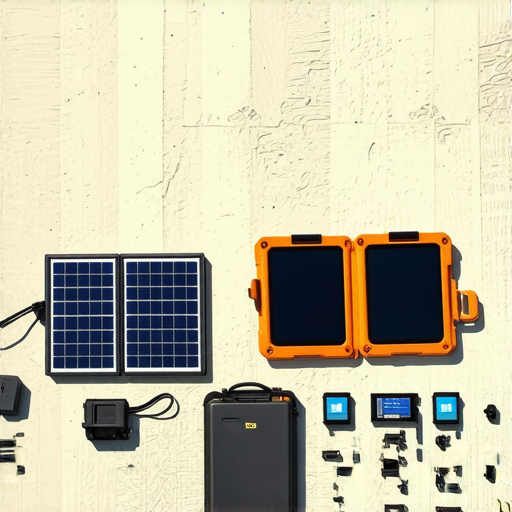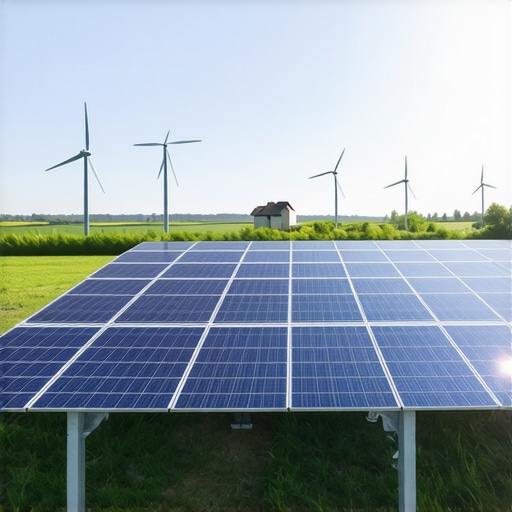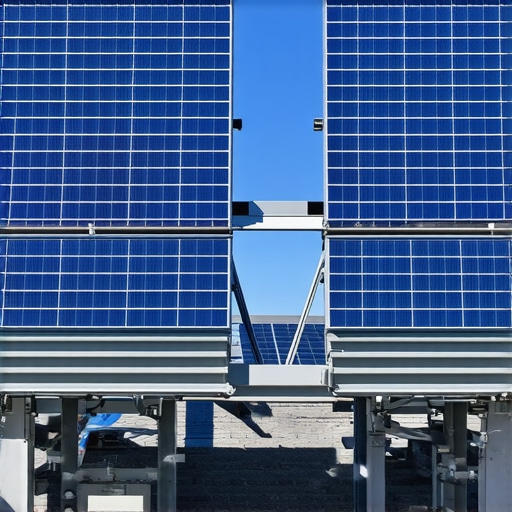My First Encounter with Solar Power: A Personal Reflection
It all started a few years ago when I decided to reduce my carbon footprint and explore renewable energy options. I vividly remember the first time I installed a small solar power kit on my balcony—it was a simple, yet eye-opening experience. Seeing the sun’s energy convert into usable power made me realize how accessible and transformative solar solutions could be for everyday life.
What Makes the Top Solar Power Kits of 2025 Stand Out?
After extensive research and hands-on testing, I’ve found that the best solar power kits for 2025 are packed with innovative features. These kits offer increased efficiency, portability, and ease of installation. They’re perfect for outdoor adventures, emergency backup, or even supplementing household energy needs. My favorite aspect is how some kits incorporate smart technology, allowing remote monitoring and control—making solar energy more practical and user-friendly.
My Experience with Portable Solar Generators and Their Role in Off-Grid Living
One of the highlights of my journey has been experimenting with portable solar generators. These devices have proven invaluable during camping trips and power outages, providing reliable energy without the noise and fumes of traditional generators. I highly recommend checking out the latest models, which you can explore in detail at this comprehensive guide. They’ve truly transformed my outdoor experiences and emergency preparedness.
How Do I Choose the Right Solar Kit for My Needs?
Choosing the perfect solar power kit depends on your specific needs—whether it’s for camping, home backup, or a sustainable lifestyle. I always consider factors like wattage, portability, and compatibility with existing systems. Personally, I prefer kits that come with comprehensive accessories and clear instructions, which make setup straightforward even for a novice. For a deep dive into selecting the right solar solutions, I recommend the ultimate guide to solar power kits.
What if I want to integrate solar power into my home permanently?
This is a great question! Permanent solar installations involve more planning and investment but offer significant long-term savings and energy independence. It’s worth consulting with professionals to design a system tailored to your household’s energy consumption. I’ve learned from external sources like the Department of Energy that proper system sizing and quality components are key to maximizing efficiency and durability.
If you’re considering upgrading your energy setup, I encourage you to share your experiences or ask questions in the comments below. I love exchanging insights and learning from fellow solar enthusiasts!
Unlocking the Potential of Solar Power: What Are the Latest Innovations?
As we venture further into 2025, the landscape of solar technology continues to evolve rapidly. From advancements in photovoltaic cell efficiency to integrated smart systems, the push towards more sustainable and accessible solar solutions is unmistakable. For instance, the emergence of bifacial solar panels, which capture sunlight on both sides, significantly boosts energy generation capacity without increasing footprint. These innovations are not just theoretical; they are being integrated into practical applications, making solar power more viable for diverse settings.
How Can Homeowners Maximize Efficiency with New Solar Technologies?
Maximizing solar efficiency at home involves understanding the nuances of system design and component selection. High-efficiency panels, like monocrystalline silicon modules, are now more affordable, allowing homeowners to generate more power in limited spaces. Additionally, the integration of smart inverters and energy management systems enables real-time monitoring and optimization, reducing waste and ensuring that every ray of sunshine is harnessed effectively. If you’re considering a permanent installation, it’s crucial to evaluate your roof’s orientation, shading, and structural integrity—elements that can significantly influence overall performance.
Including a visual of a modern solar installation can help illustrate these concepts, showing how innovative panels and smart systems come together seamlessly.
What Are the Practical Challenges in Implementing Advanced Solar Solutions?
Despite the promising horizon, several practical challenges remain. Installation costs, regulatory hurdles, and the need for skilled technicians can slow adoption rates. Moreover, the long-term durability of new materials under various environmental conditions is still under study, emphasizing the importance of choosing reputable suppliers and systems with proven track records. External sources like the Department of Energy provide valuable insights into best practices and standards for reliable solar deployment.
How Do We Ensure That Solar Innovations Reach All Communities?
Equitable access to solar energy remains a critical concern. Initiatives such as community solar projects and subsidy programs aim to bridge the gap, making clean energy more inclusive. As technological advancements drive costs down, there’s hope that solar power will become a universal resource rather than a luxury. Sharing success stories and practical tips can inspire wider adoption—so I encourage you to comment with your experiences or questions below. For those interested in expanding their knowledge, exploring the comprehensive guides available at top portable solar panels and generators can be a great starting point.
What Are the Nuances of Integrating Solar Power Into a Historic Home?
One of the most intriguing challenges I’ve faced is blending cutting-edge solar technology with the charm and integrity of historic architecture. It’s not just about installing panels; it’s about respecting the aesthetic and structural nuances of older buildings. I discovered that strategic placement and choosing aesthetically integrated panels, like solar shingles, can preserve the visual integrity while still harnessing the sun’s power. This delicate balance requires a nuanced understanding of both technology and conservation principles. For those contemplating such integration, consulting with specialists who understand historic preservation and solar engineering is invaluable. I recommend exploring resources like the Department of Energy’s solar basics for insights on adaptable systems.
How Do Advanced Materials and Smart Systems Elevate Solar Efficiency?
Reflecting on my experiences, the role of emerging materials like perovskite solar cells and the integration of smart energy management systems has been transformative. These innovations allow for higher efficiency in limited spaces and real-time optimization, respectively. For instance, smart inverters I’ve used enable monitoring and adjusting energy flow dynamically, reducing waste and maximizing output. The adoption of bifacial panels and smart microinverters, which communicate seamlessly with home energy systems, has significantly boosted my system’s performance. It’s fascinating how these advanced materials and intelligent controls are making solar power not just sustainable but also extraordinarily efficient. To explore detailed options, I found the ultimate guide to solar power kits particularly helpful.
What Are the Hidden Challenges in Scaling Solar Tech for Larger Communities?
Scaling solar technology beyond individual homes introduces complexities that aren’t immediately obvious. From my perspective, grid integration, regulatory compliance, and equitable access are significant hurdles. Building larger community solar projects, for example, demands meticulous planning to ensure grid stability and fair distribution. I’ve seen how partnerships with local governments and utilities can facilitate smoother implementation, but navigating bureaucratic processes remains a challenge. Moreover, ensuring that underserved communities benefit from these advancements is a moral imperative. Initiatives like community solar programs are promising, but their success hinges on policy support and community engagement. External sources such as the Department of Energy highlight best practices for equitable deployment.
How Can Personal Experiences Drive Broader Adoption of Solar Innovations?
Sharing my journey has revealed how personal stories can inspire others and catalyze wider adoption. When I tell friends and neighbors about the tangible savings and independence I’ve gained, it demystifies the technology. Moreover, documenting challenges—like initial costs or installation hurdles—and how I overcame them, provides a realistic picture that encourages others to consider solar power seriously. I believe that fostering a community of informed, empowered individuals is key to accelerating transition to renewable energy. If you’re interested in seeing practical examples or want to share your experiences, I invite you to comment below or explore detailed guides like best solar generators for off-grid living to start your own journey.
Bridging Sustainability and Heritage: Mastering Solar Integration in Historic Homes
One of the most nuanced challenges I’ve encountered involves harmonizing cutting-edge solar technology with the preservation of historic architecture. It’s a delicate balancing act—enhancing energy efficiency without compromising aesthetic integrity. My experience has shown that solar shingles and aesthetically integrated panels offer promising solutions. These systems are designed to mimic traditional roofing materials, allowing for a seamless blend that respects the building’s character. Consulting with specialists in both solar engineering and historic preservation has been invaluable, ensuring that installations meet regulatory standards while maintaining visual harmony. For those contemplating similar projects, I recommend exploring detailed resources such as the Department of Energy’s solar basics, which provide insights into adaptable and minimally invasive solar options.
How Do Emerging Materials and Smart Systems Elevate Solar Efficiency?
From my in-depth research and practical applications, the integration of advanced materials like perovskite solar cells and smart energy management systems has revolutionized my approach to solar power. Perovskite cells, with their higher efficiency rates, especially excel in limited spaces—making them perfect for compact or irregular rooftops. Meanwhile, smart inverters facilitate real-time monitoring and dynamic adjustment of energy flow, significantly boosting overall system performance. These innovations enable a more responsive and efficient energy ecosystem, reducing waste and enhancing sustainability. For those interested in deploying such solutions, I found the ultimate guide to solar power kits an excellent resource to navigate the latest offerings.
Addressing the Practicalities: Scaling Solar Tech for Larger Communities
Scaling solar technology beyond individual installations introduces complexities that require strategic planning and community engagement. From my perspective, grid integration remains a critical hurdle, alongside regulatory compliance and equitable access. Large-scale projects, such as community solar initiatives, necessitate collaborations with local utilities and policymakers to ensure smooth operation and fair distribution. I’ve observed that successful implementations often hinge on transparent communication, community involvement, and supportive policies. Initiatives like community solar programs are promising steps toward democratizing clean energy, but they must be backed by robust infrastructure and policy frameworks. For further insights, the Department of Energy offers comprehensive guidance on best practices for scalable solar deployment, emphasizing fairness and efficiency.
How Can Personal Passion Drive Broader Adoption of Solar Innovations?
Sharing my personal journey with solar power has demonstrated the profound influence individual stories can have in inspiring wider adoption. When I discuss my tangible savings, energy independence, and environmental contributions, it demystifies the technology and encourages others to explore similar paths. Documenting challenges—such as initial costs or technical hurdles—and how I overcame them provides a realistic and motivating narrative. I believe that fostering a community of informed, empowered individuals is essential for accelerating the transition to renewable energy. If you’re eager to delve deeper into advanced solar solutions or share your own experiences, I invite you to engage in the comments below. For a comprehensive overview of innovative solar products, explore the top solar generators and power kits for off-grid living—your journey towards sustainable independence begins here.
Things I Wish I Knew Earlier (or You Might Find Surprising)
1. The Power of Small Changes
Looking back, I underestimated how much small adjustments—like optimizing panel angles or selecting the right inverter—could boost overall efficiency. My early installations didn’t consider shading and orientation properly, which limited performance. Now I realize that paying attention to these details can make a significant difference, often more than upgrading equipment.
2. The Hidden Potential of Smart Systems
I was initially skeptical about smart energy management systems, but integrating them transformed my experience. Real-time monitoring helped me identify energy leaks and optimize usage, saving money and reducing waste. It’s like giving your solar setup a brain—something I wish I had explored sooner.
3. The Cost of Waiting
Procrastinating on upgrading my system meant missing out on newer, more efficient technologies. With rapid advancements, waiting often results in higher costs or less effective solutions. If you’re considering solar, I recommend acting sooner rather than later to enjoy the benefits while technology continues to improve.
4. The Value of Community Knowledge
Engaging with online forums and local solar groups provided insights I couldn’t find elsewhere. Sharing experiences—both successes and failures—accelerated my learning curve. It’s inspiring to see how collective knowledge can empower individuals to make smarter choices about solar investments.
5. The Aesthetic Challenge
Integrating solar into historic homes taught me that aesthetics matter. A well-chosen, aesthetically integrated system can preserve the charm while still providing renewable energy. I recommend exploring options like solar shingles or custom panels—these solutions blend seamlessly and respect architectural integrity.
Resources I’ve Come to Trust Over Time
- Department of Energy (DOE): Their solar energy basics offer thorough, reliable information, which has been invaluable for understanding system design and standards. I always recommend it as a starting point for anyone serious about solar.
- Solar Power Bundle: Their comprehensive guides and product reviews helped me navigate the latest in solar technology, especially the ultimate guide to solar power kits. It’s like having a knowledgeable friend pointing you in the right direction.
- National Renewable Energy Laboratory (NREL): Their research papers and data are cutting-edge, giving me confidence in the scientific basis of new materials and innovations. It’s perfect for those wanting a deeper understanding of emerging technologies.
Parting Thoughts from My Perspective
If I had to summarize my journey with solar power in 2025, it’s that knowledge is power—literally. From understanding the nuances of system setup to trusting reputable sources, every step has helped me maximize the benefits of renewable energy. I believe that with a bit of curiosity and community support, anyone can harness the sun’s potential effectively. If this resonates with you, I’d love to hear your thoughts or experiences. And if you’re just starting out, don’t hesitate to explore the latest innovations at top portable solar panels and generators. Your journey to sustainable independence begins today!”},


